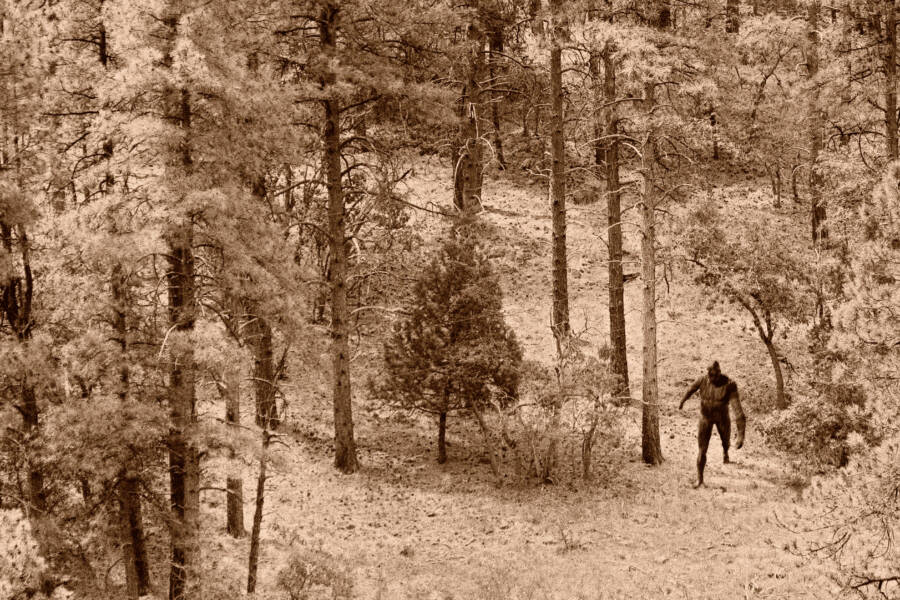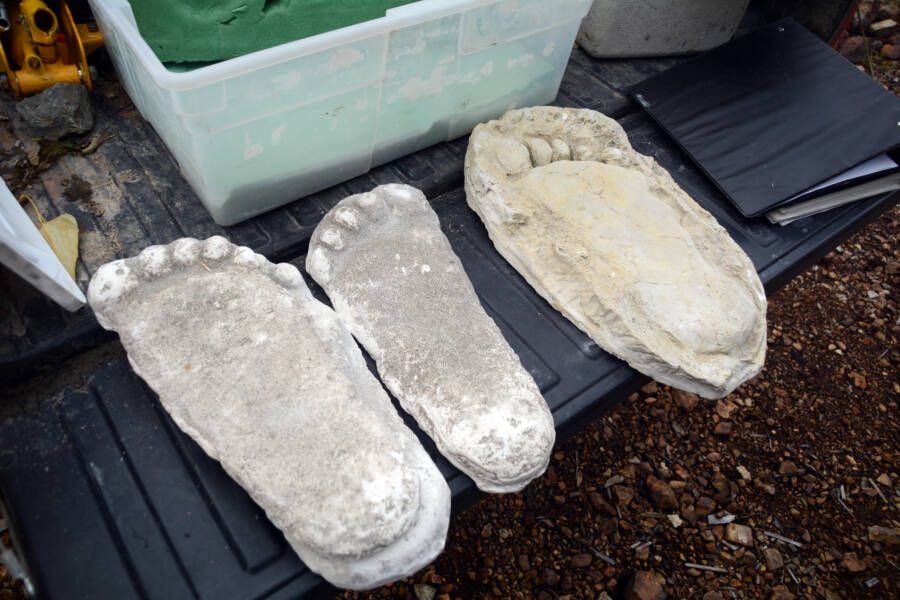Rumors about the Sasquatch have circulated for centuries, and while there has never been any conclusive evidence to prove that Bigfoot is real, a number of reputable scientists believe it’s possible.

Wikimedia CommonsA frame of the Patterson-Gimlin film, the most famous “evidence” that Bigfoot is real.
Bigfoot is easily the most famous cryptid in American folklore. Otherwise known as Sasquatch, the hairy, bipedal creature has been a popular figure for decades, particularly in cryptozoology circles. But this fascination isn’t just relegated to the fringe. Even the FBI at one point opened an investigation to answer this question: Is Bigfoot real?
Answering that question isn’t as straightforward as it might seem. Various studies over the years have sought to prove — or disprove — Bigfoot’s existence. Eyewitness accounts, grainy photographs, and strange footprints have fueled the mystery, with some believers arguing that these pieces of evidence show that Bigfoot is real, while skeptics point to the lack of irrefutable proof and the possibility of hoaxes or misidentification of known wildlife.
And while there is no official consensus, this decades-old debate continues to captivate the public’s imagination.
The Most Famous Sightings Of Bigfoot
While it’s not clear exactly when rumors about Sasquatch first began to spread, what is clear is that by the mid-1900s, the hunt for the cryptid was well and truly on.
The most famous purported Bigfoot sighting is, of course, the 1967 Patterson-Gimlin film. The grainy 16mm footage was allegedly captured on Oct. 20 by Roger Patterson and Bob Gimlin near Bluff Creek in Northern California and appears to show a tall, hairy figure strolling through the forest.

Dale O’Dell/Alamy Stock PhotoThe Bigfoot Field Researchers Organization lists sightings in every U.S. state except Hawaii.
The Patterson-Gimlin film catapulted Bigfoot into the national spotlight. However, many believe the filmmakers faked the footage to make a profit; indeed, Roger Patterson took the short film on a nationwide tour and even published a book on Bigfoot.
But to this day, experts have failed to definitively debunk the footage. Many still view it as one of the most compelling pieces of evidence for Bigfoot’s existence.
But Patterson and Gimlin’s experience is far from the only purported sighting of Bigfoot. And over the years, people across North America have found footprints they say are evidence that Bigfoot exists.
In August 1980, for instance, locals near Johnstown, Pennsylvania discovered a massive footprint measuring 17.75 inches long. Some witnesses even complained of a strange smell in the air — a common feature of Bigfoot sightings.
Other purported Bigfoot sightings come to us from U.S. Forest Service workers, mountain climbers, university professors, and even former skeptics. The search for the elusive cryptid has become so widespread that in 1995, the Bigfoot Field Researchers Organization (BFRO) was established to keep track of the myriad sightings reported annually across the country.
Bigfoot sightings continue to make headlines to this day. As recently as October 2023, a video that appeared to show a Sasquatch hiding in the hills of Colorado went viral online.
It’s story time y’all! On Sunday, October 8, 2023, Stetson Tyler and I took the Narrow Gauge train ride from Durango to…
Posted by Shannon Parker on Tuesday, October 10, 2023
Still, skeptics argue that there is not enough actual proof to conclude that Bigfoot is real. Photographs and videos can be doctored or fabricated, for instance, and evidence of massive footprints, while strange, is hardly conclusive.
However, there are some scientists who believe that Bigfoot is real based on the existing evidence.
Examining The “Evidence” That Bigfoot Is Real
Various experts have weighed in on the Bigfoot debate over the years.
In 2003, for example, police investigator Jimmy Chilcutt spoke with National Geographic about forensic evidence that convinced him of Bigfoot’s existence.
Chilcutt was a member of the Conroe Police Department in Texas and a specialist in finger- and footprint analysis. After analyzing more than 150 casts of alleged Bigfoot prints that Idaho State University professor Jeff Meldrum had been keeping in a laboratory, he said some of the prints were “different from anything I’ve ever seen.”
One footprint in particular, found in Walla Walla, Washington in 1987, convinced Chilcutt that Bigfoot is real.
“It certainly wasn’t human, and of no known primate that I’ve examined,” he said. The most telling signs, according to Chilcutt, were the print ridges, which flowed lengthwise as opposed to across, like a human’s. The texture revealed that whatever creature made the prints had a “real thick skin,” about twice the thickness of a human’s.

John Zada/Alamy Stock PhotoPlaster casts of alleged Bigfoot footprints.
Meldrum, meanwhile, insisted that another large print specimen known as the Skookum Cast offers strong evidence of Bigfoot’s existence.
This plaster cast, made in September 2000 by a group of Bigfoot researchers in Washington state, seemed to indicate the impressions of a forearm, a thigh, buttocks, an Achilles tendon, and a heel that were “40 to 50 percent bigger than a normal human,” according to Meldrum.
“The anatomy doesn’t jive with any known animal,” he said.
Of course, for every expert like Meldrum and Chilcutt who believes Bigfoot is real, there are a handful of others who emphatically disagree with the notion.
The biggest issue, skeptics say, is that no Sasquatch has ever been captured, and no one has ever recovered Sasquatch remains. There has never been any other concrete physical evidence aside from possible prints.
At one point in the 1970s, however, it briefly seemed as though a group of Bigfoot researchers may have uncovered DNA evidence.
The FBI Investigates The Cryptid
In 1976, Director Peter Byrne of the Bigfoot Information Center and Exhibition in The Dalles, Oregon found a small sampling of “about 15 hairs attached to a tiny piece of skin” that the organization could not identify, according to Newsweek.
Byrne sent the hair sample off to the FBI, hoping they could analyze it and provide any other documentation about Bigfoot they may have collected over the years.
Shockingly, the FBI did analyze it — meaning the FBI has officially looked into Bigfoot on at least one occasion. In early 1977, Jay Cochran Jr., assistant director of the FBI’s scientific and technical services division, sent the sample back to Byrne with his final assessment: The hairs had come from a deer.

Ian Dagnall/Alamy Stock PhotoThe Bigfoot Museum in Willow Creek, California.
Needless to say, it wasn’t exactly the smoking gun Byrne had hoped for. The FBI officially released its “Bigfoot file” in 2019, alerting the rest of the world to this somewhat disappointing conclusion.
As of 2024, little has changed. There is still no conclusive evidence that Bigfoot exists — no DNA samples, no captured specimens, and no photographs or videos that can be proven to be 100 percent genuine.
Of course, that hasn’t stopped people from believing.
Why Do People Believe That Bigfoot Is Real?
Nearly 60 years after the Patterson-Gimlin film helped popularize the story of Bigfoot, we are no closer to confirming the cryptid’s existence. Why, then, do so many people still believe in it?
The answer to this question certainly varies from person to person. For some, the sheer number of alleged prints and sightings is all of the support they need. And many of these pieces of evidence, like the Patterson-Gimlin film, have yet to be definitively debunked.
For others, the pursuit of Bigfoot is a romantic, adventurous one; it is simply more fun to believe in this legendary creature than it is not to.
For her part, famed primatologist Jane Goodall has said she hasn’t ruled out the possibility that Bigfoot exists.
“Every single country has its version,” she told GQ in 2021. “Yeti, Yowie in Australia, Wild Man in China… Is the last of the Neanderthals still living in these remote forests? I don’t know. But I’m not going to say it doesn’t exist and I’m not going to say people who believe in it are stupid.”

Wikimedia CommonsA carved statue of Bigfoot at the Bigfoot Trails.
As the saying goes, absence of evidence is not evidence of absence. Scientists discover new animal species all the time. The difference is that, in most of these cases, leagues of amateurs are not also actively searching for these creatures.
But even with thousands of Bigfoot enthusiasts out looking for evidence, we may never be able to fully determine, one way or the other, whether Bigfoot is real.
After reading about whether Bigfoot is real, meet the Yowie, the Bigfoot-like monster of Australian folklore. Or, learn about the Orang Pendek, the hobbit-like creature said to roam the remote forests of Indonesia. Finally, learn about Florida’s Bigfoot, the Skunk Ape.





